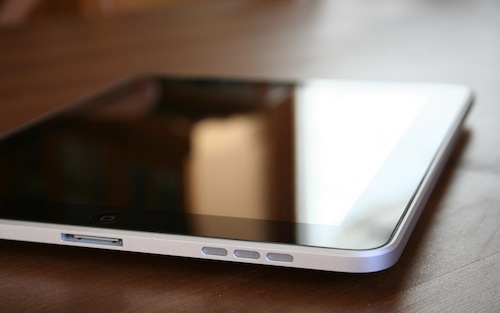In the first beta of iOS 4.3, Apple introduced “multitasking gestures” for iPad: offered as a preview for developers to play with and test compatibility with apps, these 4 and 5-finger multitouch gestures allow users to execute a series of actions otherwise assigned to the Home button. You can switch back and forth between apps, open and close the multitasking tray or pinch back to the homescreens. The gestures need to be activated through Xcode as, again, they are a developer preview of a feature that won’t even be enabled in the public release of iOS 4.3, as Apple let devs know last night.
The presence of gestures that offer some functionalities previously exclusive to the Home button also let the rumor mill run wild, with some bloggers speculating that Apple may get rid of the Home button in the next iterations of the iPad and iPhone. Personally, I think gestures on the iPhone’s tiny screen are a terrible idea – and it gets worse if you have non-average, big hands.
Gestures are a neat new feature for the iPad that provide a glimpse at something Apple is clearly working on: more multi-touch capabilities for iOS devices. These very same gestures, though, gave several developers a hard time trying to figure out how to integrate them with their apps.
The problem with the new gestures is that Apple decided to make them system-wide, activated with a preference panel in the Settings app. Once gestures are enabled, they override any other four or five finger gesture developers may have implemented in applications. Personally, in fact, I have experienced issues trying to use multi-touch gestures in Edovia’s Screens or other piano apps – software that makes extensive use of gestures above two and three fingers. Apple’s implementation overrides options set by developers, and there is no way to let the iPad know whether a user wants to perform an app-specific gesture or a system one, like “open the multitasking tray”. Looking forward, developers fear that Apple might just use four and five finger gestures for its own iOS functionalities, and leave third-party apps in the dust with multi-touch recognition below four fingers. As you can guess, this can be a problem with many kinds of apps: music apps, painting software, VNC clients, and so forth.
A design patent Apple was awarded last year after the iPad announcement offers, in my opinion, a hint at what Apple may implement in future iOS devices to figure out a solution for system and third-party gestures. The patent for “touch-sensitive bezels on portable devices” would allow the engineers at Cupertino to design devices capable of recognizing gestures coming from the bezel as system ones, and gestures performed directly on the screen as app-specific ones.
The bezel could have invisible or visible touch areas that could be programmed to control such things as music volume, simple zooming functions for maps or even gaming controls. Considering that Apple’s new iPad has a considerable sized bezel, you have to wonder if this is what they have in mind for that bezel in the future. Apple has also gained a second advanced virtual keyboard and touch based patent in the last 90 days that actually plays into the strengths of the intelligent bezel.
Looking back at the patent now (which was filed in 2006, even before the iPhone announcement), it all seems pretty obvious: someday, Apple will create an “intelligent system” that can figure out on its own whether or not the user wants to activate a system gesture or an app command. If I’m not mistaken, a similar touch-sensitive bezel technology can be found in Palm’s devices and the upcoming BlackBerry PlayBook.
Still, Apple is awarded dozens of patents every month and speculating on them as reference for new features and products is often a bad practice. But there’s no doubt Apple will need to find a way to let system gestures and third-party apps coexist.


